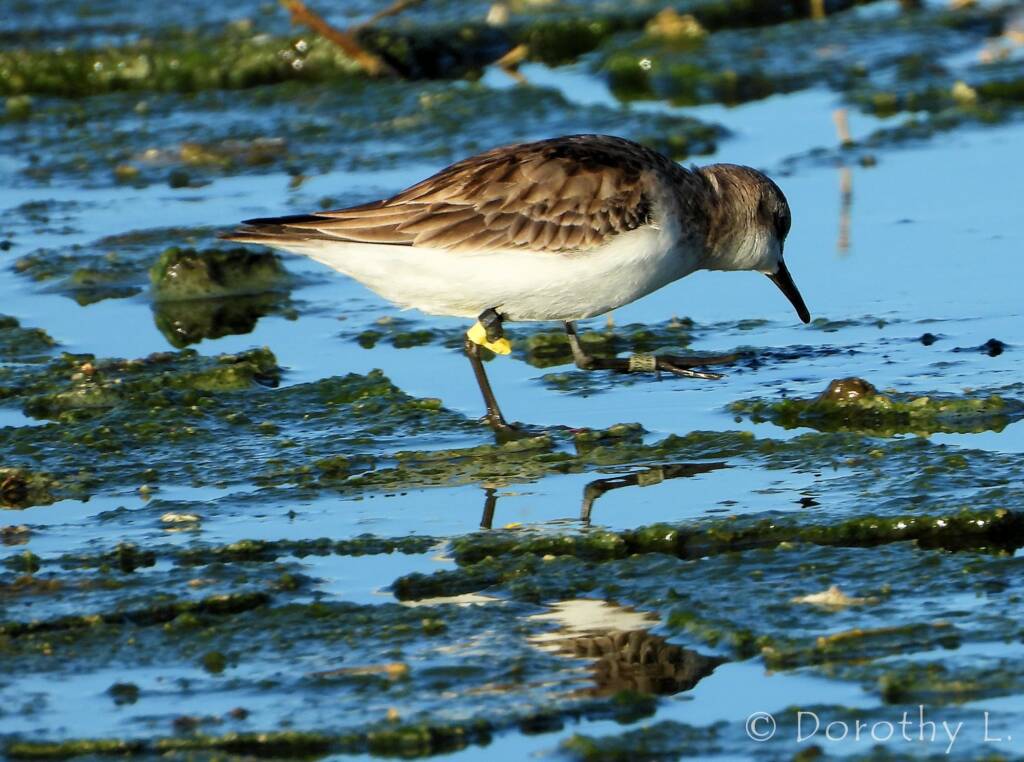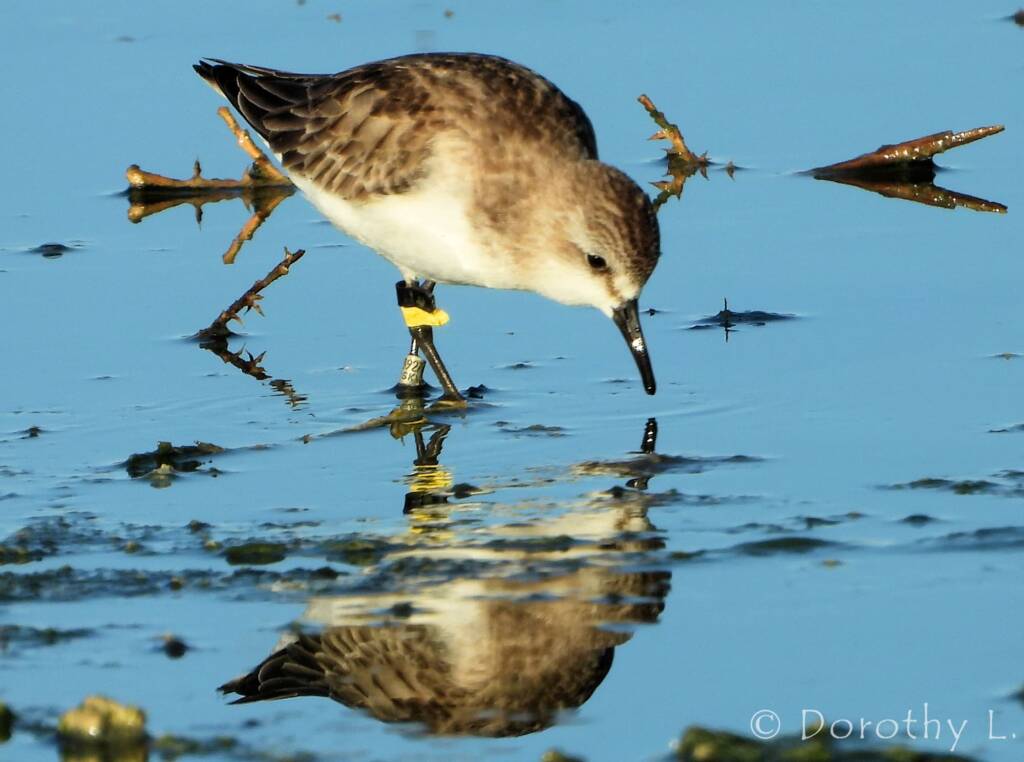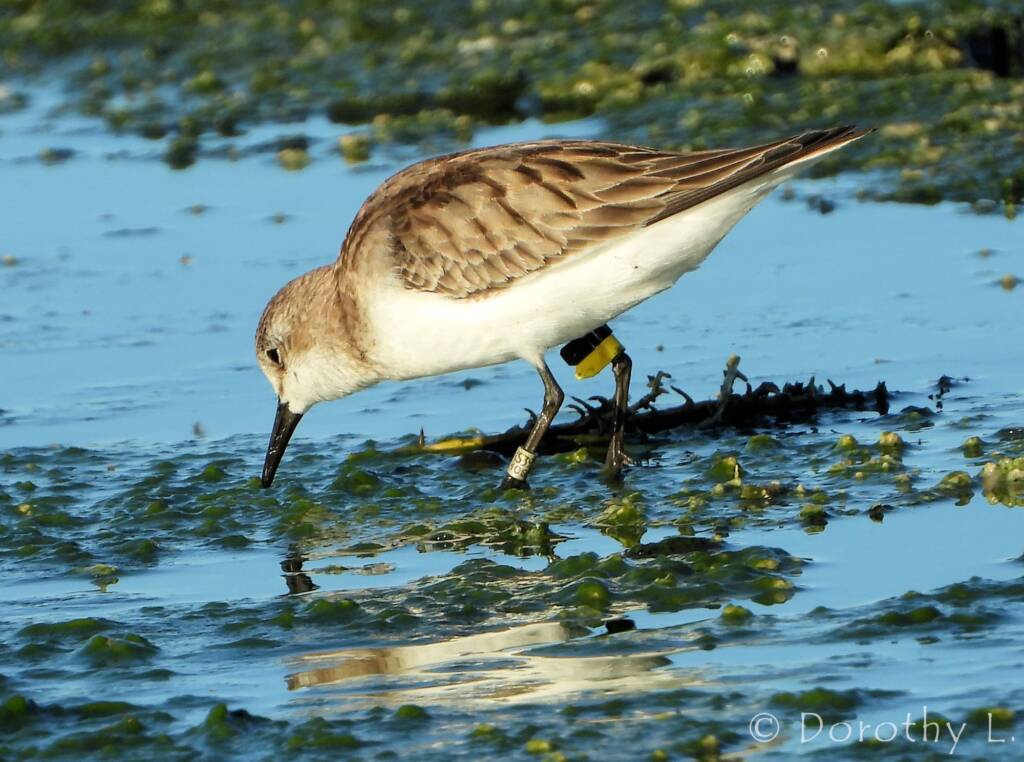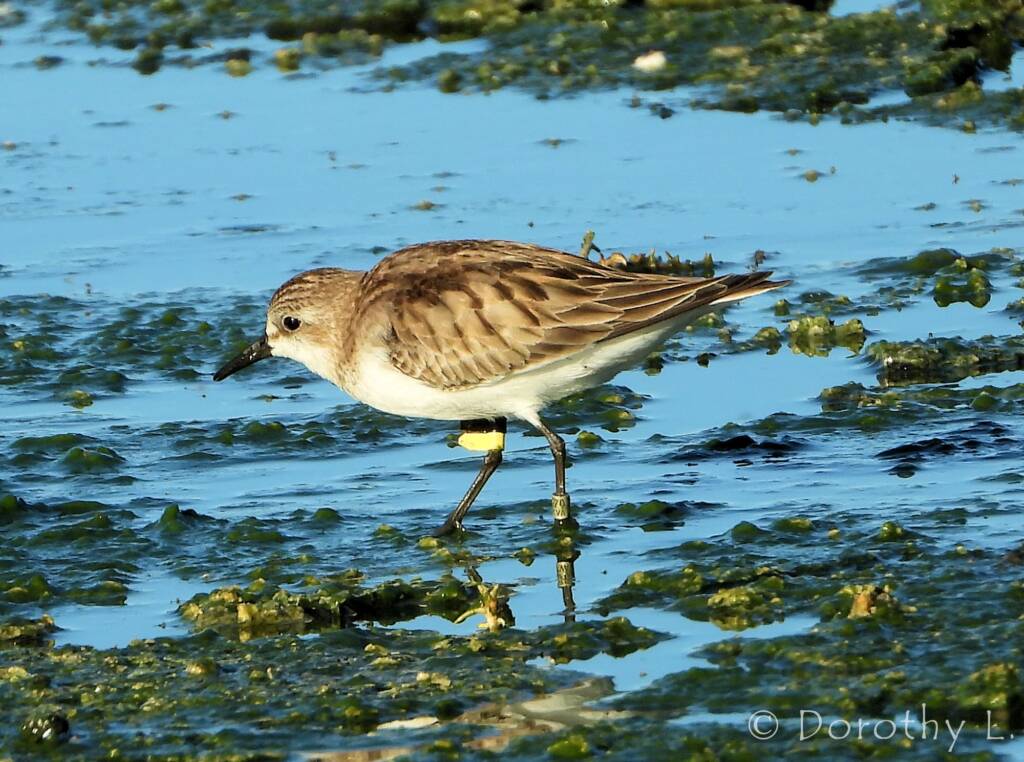Red-necked StintRed-necked Stint – Bird Banding & Flagging
Bird watchers may on occasion see birds that have bird banding and leg flagging tags on their legs. These are part of research projects by different organisations around the world. Projects like these map the population and the migratory flight paths of many species of birds that travel thousands of kilometres.
Migration is thought to be driven mostly by weather and the availability of food. Birds will migrate to temperate regions due to season changes, and where food is plentiful, as well as driven by mating and nesting desires.
The images here are of a banded and flagged Red-necked Stint (Calidris ruficollis), who are small migratory waders that will seek out inland and coastal wetlands, estuaries and other available water sources.

Here you can see two coloured flags (black and yellow) on the right leg and an metal stamped tag on the left leg – (the code on the metal tag appears to be 539270 MOSKVA).






Coloured flags are used by researchers studying movements of shorebirds along what is known as the East Asian Flyway. Each locality or country has its own banding colour combination. When sighting a live bird bearing the coloured bands, it is important to know the exact sequence of colours and the position of the bank on the leg, eg in the photos here, there is a black (top) and yellow (below) flag tag on the birds upper right leg, whilst the metal tag is on the lower left leg.

The Australian Bird and Bat Banding Scheme (ABBBS) established a protocol of colour banding for individual recognition of sedentary species, that permits the use of three colour bands together with a metal band at a fixed position.
You can report the sighting on BirdMark — Tagging • Tracking • Reporting —
and they will email you the history of this individual
https://vhost2009.hosted-sites.deakin.edu.au/importing/import.php
- Scientific classification
- Kingdom: Animalia
- Phylum: Chordata
- Class: Aves
- Order: Charadriiformes
- Family: Scolopacidae
- Genus: Calidris
- Species: Calidris ruficollis
Footnote & References
- Finding birds with bands or other marks, Australian Museum, https://australian.museum/learn/species-identification/ask-an-expert/finding-birds-with-bands-or-other-marks/
- Individual Colour Banding for 8 000 Birds, J Kikkawa, Department of Zoology, The University of Queensland, Brisbane, QLD 4072, Received 15 July 1996, https://absa.asn.au/wp-content/uploads/2014/12/C211026.pdf
- Shorebird Color Flagging Protocol on the East Asian-Australasian Flyway (As of 17 Nov 2015), https://eaaflyway.net/wp-content/uploads/2017/12/Protocol_birds-marking.pdf
- Bird Banding and Leg Flagging, BirdLife Australia, https://birdlife.org.au/images/uploads/education_sheets/INFO-bird-banding.pdf
- Report Band Sightings, The Shorebird ecological demographics and conservation initiative, Global Flyway Network, http://globalflywaynetwork.com.au/report-band-sightings/
- Australian Bird and Bat Banding Scheme (ABBBS), https://www.awe.gov.au/science-research/bird-bat-banding/banding-data/search-abbbs-database
- AWSG — Australasian Wader Study Group, The Australasian Wader Studies Group (AWSG) was formed in 1981 as a special interest group of BirdLife Australia to coordinate and focus studies on waders, or shorebirds, in Australia and throughout their migration routes in the Asia Pacific, https://awsg.org.au/
- VWSG — Victorian Wader Study Group, The Victorian Wader Study Group (VWSG) began its activities in 1975. The VWSG’s primary objective is to conduct a long-term comprehensive study of waders and terns throughout Victoria. This is achieved primarily through capture and release of birds at key high tide roosts. The VWSG is a non-profit organisation and is made up of around 140 volunteers, https://vwsg.org.au/
Red-necked StintRed-necked Stint – Bird Banding & Flagging
WadersBanded Lapwing Bar-tailed Godwit Black-fronted Dotterel Glossy Ibis (Plegadis falcinellus) Hooded Plover Inland Dotterel Lesser Sand Plover Long-toed Stint Oriental Plover Pacific Golden Plover Pectoral Sandpiper Pied Stilt Red-necked Avocet Red-necked Stint Ruff Sanderling Sharp-tailed Sandpiper Sooty Oystercatcher
BirdsApostlebird Australasian Darter Australasian Figbird Australasian Gannet Australasian Grebe Australasian Pipit Australasian Robins Australasian Shoveler (Spatula rhynchotis) Australasian Wrens Australian Babblers Australian Bustard Australian Chats Australian Magpie Australian Pelican Australian Pratincole (Stiltia isabella) Australian White Ibis Bassian Thrush Black-faced Cormorant Black-faced Woodswallow Black Swan Bowerbirds Brolga Brown Songlark Channel-billed Cuckoo Cinnamon Quail-thrush Cormorants Cuckooshrikes and Allies Dotterels Lapwings Plovers Doves & Pigeons Emu Fairy Martin Finches Grey Fantail Grey Teal Honeyeaters Kingfishers Little Friarbird Little Grassbird Magpie-lark Masked Woodswallow Noisy Pitta Olive Whistler Paradise Riflebird Pardalotes Parrots Pheasant Coucal Pied Butcherbird Rainbow Bee-eater Raptors Rufous Fantail Redthroat Rufous Bristlebird Silver-crowned Friarbird Torresian Crow Waders Welcome Swallow (Hirundo neoxena) Whiskered Tern (Chlidonias hybrida) White-browed Woodswallow White Capped Noddy White-faced Heron White-necked Heron Willie Wagtail Yellow-throated Scrubwren
